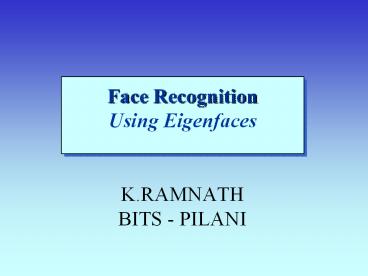Face Recognition Using Eigenfaces K.RAMNATH BITS - PILANI - PowerPoint PPT Presentation
Title:
Face Recognition Using Eigenfaces K.RAMNATH BITS - PILANI
Description:
Face Recognition Using Eigenfaces K.RAMNATH BITS - PILANI Introduction Why face recognition ? Eigen-faces (overview) Project Evolution Future scope The image-space ... – PowerPoint PPT presentation
Number of Views:602
Avg rating:3.0/5.0
Title: Face Recognition Using Eigenfaces K.RAMNATH BITS - PILANI
1
Face Recognition Using EigenfacesK.RAMNATH
BITS - PILANI
2
Outline
- Introduction
- Why face recognition ?
- Eigen-faces (overview)
- Project Evolution
- Future scope
3
Introduction
This is a face recognition system, based on
EIGENFACES method. The method is both intuitive,
simple to express in mathematical terms, and very
flexible.
4
Why Face Recognition
- An interesting field
- Lots of applications
- - Security
- - Intelligent Computer-User interaction
- - Available resources
5
EIGEN FACES
Any face in a graphic image format can be viewed
as a vector by concatenating the rows of the
image one after another
6
The Eigenface Method
Eigenfaces is to a set of basis functions that if
linearly combined could represent any face.
7
EIGENFACES
- Eigenfaces are used for the recognition and
detection of (among other things) human faces.
8
Eigenfaces
- These photographs comprise a training set, and
it is this training set that the eigenfaces are
extracted from. - The photographs in the training set are mapped
to another set of fifteen images which are the
eigenfaces. - The photographs in the training set is one
domain, and the fifteen eigenfaces comprise the
second domain that is often referred to as the
face space.
9
EIGENFACES
eigenfaces
10
Eigenfaces
- Once the eigenfaces have been computed, the
system can transform any face image to it's face
vector. - Any face image that is to be tested is then
transformed to it's face vector representation.
Euclidean distance is then used to find the
stored face vector that comes closest to the test
face vector, and the face is recognized.
11
Project Evolution
THE FACE DETECTION AGORITHM 1) Collect all gray
levels in a long vector u. 2) Collect n samples
(views) of each of a person in matrix A (MN X
n) 3) Form a correlation matrix L (MN X
MN) LAAT 4) Compute eigen vectors of L, which
forms the bases for whole face space. Each face,
u, can now be represented as a linear
combinationof eigen vectors.
12
PROJECT EVOLUTION
Training Create A matrix from training
images Compute C matrix from A. Compute
eigenvectors of C. Compute eigenvectors of L
from eigenvectors of C. Select few most
significant eigenvectors of L for face
recognition. Compute coefficient vectors
corresponding to each training image. For each
person, coefficients will form a cluster, compute
the mean of cluster.
13
- The image-space and face-space
14
PROJECT EVOLUTION
Recognition Create a vector u for the image
to be recognized. Compute coefficient vector
for this u. Decide whether the image is a face
or not, based on the distance from the cluster
mean.
15
FUTURE SCOPE
Some possible extensions for this project over
future years could be 1)More advanced lighting
normalization algorithms before applying
eigenfaces method 2)Use of eigenfeatures to
increase robustness to change in expression
3)use of multiple subspaces to allow for
detection from general perspectives, ie.
recognition from profile images 4)A maximum a
posteriori (MAP) rule for face detection and
recognition which allows the system to be trained
not only with positive examples of a
face/individual, but also with negative examples































